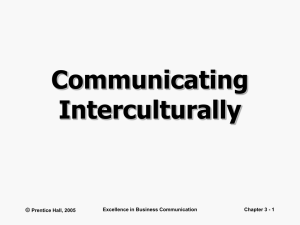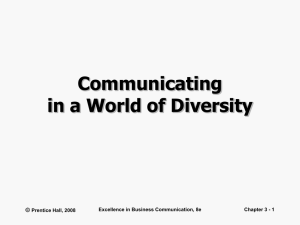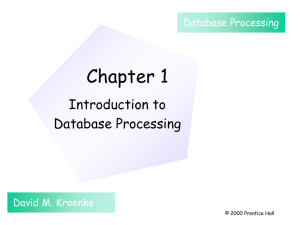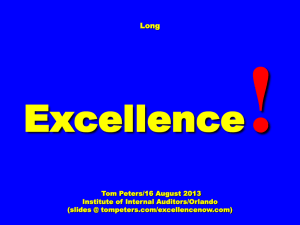Communicating in Teams and Mastering Listening, Nonverbal
advertisement
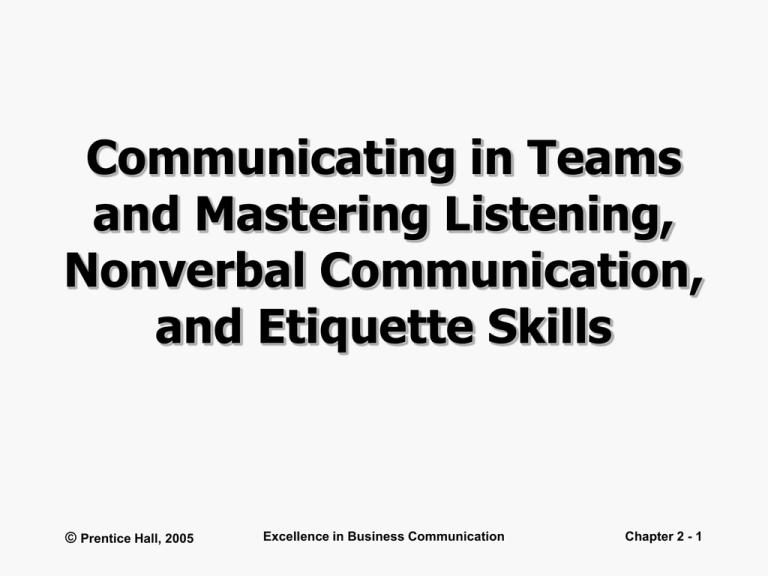
Communicating in Teams and Mastering Listening, Nonverbal Communication, and Etiquette Skills © Prentice Hall, 2005 Excellence in Business Communication Chapter 2 - 1 Working in Teams Two or More People Common Goal Shared Mission Shared Responsibility © Prentice Hall, 2005 Excellence in Business Communication Chapter 2 - 2 Workplace Teams Problem Solving Task Forces Committees Virtual Teams © Prentice Hall, 2005 Excellence in Business Communication Chapter 2 - 3 Overview of Teams Advantages Information Diversity & knowledge of views Acceptance of solutions Performance © Prentice Hall, 2005 Disadvantages Groupthink Hidden agendas Free riders High costs Excellence in Business Communication Chapter 2 - 4 Group Dynamics Rules Norms Identity © Prentice Hall, 2005 Excellence in Business Communication Chapter 2 - 5 Team-Member Roles SelfOriented GroupMaintenance TaskFacilitating •Controlling •Encouraging •Initiating •Withdrawing •Harmonizing •Information Seeking •Attention Seeking •Compromising •Coordinating •Diverting © Prentice Hall, 2005 •Procedure Setting Excellence in Business Communication Chapter 2 - 6 Team Decision Making • Orientation • Conflict • Brainstorming • Emergence • Reinforcement © Prentice Hall, 2005 Excellence in Business Communication Chapter 2 - 7 Conflict in Teams • Scarce resources • Task responsibilities • Poor communication • Attitudes and values • Power struggles • Conflicting goals © Prentice Hall, 2005 Excellence in Business Communication Chapter 2 - 8 Types of Conflict Constructive Destructive Exposes Issues Diverts Energy Boosts Involvement Destroys Morale Generates Ideas Divides the Team © Prentice Hall, 2005 Excellence in Business Communication Chapter 2 - 9 Conflict Resolution Strategies Win-Lose © Prentice Hall, 2005 Win-Win Excellence in Business Communication Lose-Lose Chapter 2 - 10 Overcome Resistance • Express understanding • Raise awareness • Evaluate objections • Withhold arguments © Prentice Hall, 2005 Excellence in Business Communication Chapter 2 - 11 Clear Purpose Effective Teams Consensus Decision Making Creative Thinking Focused Efforts © Prentice Hall, 2005 Open Communication Collaborative Relationships Excellence in Business Communication Conflict Resolution Chapter 2 - 12 Collaborative Writing Team Members Strong Leadership Cooperation Clear Goals © Prentice Hall, 2005 Excellence in Business Communication Chapter 2 - 13 Collaborative Writing Solid Commitment Clear Responsibility Prompt Action Appropriate Technology © Prentice Hall, 2005 Excellence in Business Communication Chapter 2 - 14 Critiquing Writing • Clear instructions • Purpose of the document • Correct factual material • Unambiguous language © Prentice Hall, 2005 Excellence in Business Communication Chapter 2 - 15 Purpose Participants PRODUCTIVE MEETINGS Agenda © Prentice Hall, 2005 Location Excellence in Business Communication Chapter 2 - 16 Effective Meetings Focus Procedures Participation Closing Follow-Up © Prentice Hall, 2005 Excellence in Business Communication Chapter 2 - 17 Usage of Business Communication Channels Speaking 30% Listening 45% Receiving Sending Writing 9% Reading 16% © Prentice Hall, 2005 Excellence in Business Communication Chapter 2 - 18 The Listening Process Message Receiving Interpreting Remembering Feedback Message Responding Evaluating Message © Prentice Hall, 2005 Excellence in Business Communication Chapter 2 - 19 Barriers to Listening Physical Distractions Differing Viewpoints Poor Note Taking Prejudgment Self-Centeredness Selective Listening Speech/Though Disparity Inappropriate Reaction © Prentice Hall, 2005 Excellence in Business Communication Chapter 2 - 20 Benefits of Listening Strengthen Relationships Recognize Innovation © Prentice Hall, 2005 Enhance Productivity Manage Diversity Excellence in Business Communication Gain a Personal Edge Chapter 2 - 21 Listening Guidelines Match Listening Style to Speaker Purpose Minimize Physical Distractions Practice Active Listening Provide Appropriate Feedback © Prentice Hall, 2005 Excellence in Business Communication Chapter 2 - 22 Intent Less Structured Harder to Classify More Spontaneous Less Control More Structured Easier to Study Conscious Purpose More Control Verbal Verbal Structure Nonverbal Nonverbal Basic Communication © Prentice Hall, 2005 Excellence in Business Communication Chapter 2 - 23 Types of Nonverbal Communication Facial Expressions Gestures and Posture Use of Time and Space Vocal Characteristics Touching Behavior Personal Appearance © Prentice Hall, 2005 Excellence in Business Communication Chapter 2 - 24 Functions of Nonverbal Communication • Reinforcement • Negation • Substitution • Intensification • Regulation © Prentice Hall, 2005 Excellence in Business Communication Chapter 2 - 25 Detecting the Truth © Prentice Hall, 2005 Response Time Distancing Uneven Speech Gap Filling Raised Pitch Squirming Eye Contact Micro Expressions Comfort Gestures Excellence in Business Communication Chapter 2 - 26 Maximizing Credibility Eye Behavior Gestures Posture Voice © Prentice Hall, 2005 Excellence in Business Communication Chapter 2 - 27 Improving Business Etiquette Appearance Personal Grooming Wardrobe & Accessories Interactions Face-toFace Over the Telephone Workplace Behaviors © Prentice Hall, 2005 Excellence in Business Communication Chapter 2 - 28 Workplace Appearance Smooth and Finished Elegant and Refined Crisp and Starchy Up-to-the Minute Trendy © Prentice Hall, 2005 Excellence in Business Communication Chapter 2 - 29 Face-to-Face Interactions Smiling Shaking Hands Making Introductions Sharing Meals © Prentice Hall, 2005 Excellence in Business Communication Chapter 2 - 30 Telephone Interactions Use Verbal Responses Increase Volume Slightly Vary Pitch and Inflection Speak to Be Understood Attitude Tone of Voice Listening Speaking © Prentice Hall, 2005 Excellence in Business Communication Chapter 2 - 31 Receiving Phone Calls Answer Promptly With a Smile Identify Yourself Establish the Caller’s Needs © Prentice Hall, 2005 Excellence in Business Communication Chapter 2 - 32 Receiving Phone Calls Stay Positive Take Accurate Messages Explain Your Actions © Prentice Hall, 2005 Excellence in Business Communication Chapter 2 - 33 Making Phone Calls Plan and Schedule Your Calls Minimize Distractions Introduce Yourself © Prentice Hall, 2005 Excellence in Business Communication Chapter 2 - 34 Making Phone Calls Don’t Waste Time Maintain Focus Close on a Positive Note © Prentice Hall, 2005 Excellence in Business Communication Chapter 2 - 35 Using Voice Mail Brief Statements Professional Tone Caller-Focus Helpful Options Current Message Prompt Response © Prentice Hall, 2005 Excellence in Business Communication Chapter 2 - 36 Leaving Voice Mail Keep It Simple Sound Professional Avoid Personal Messages © Prentice Hall, 2005 Excellence in Business Communication Chapter 2 - 37 Leaving Voice Mail Replay the Message Avoid Multiple Messages Don’t Hide Behind Voice Mail © Prentice Hall, 2005 Excellence in Business Communication Chapter 2 - 38
